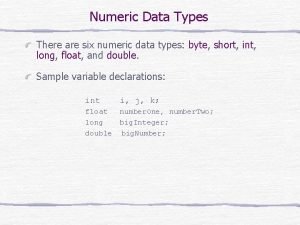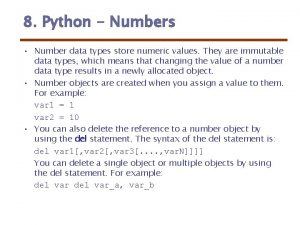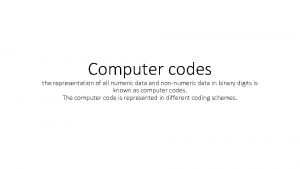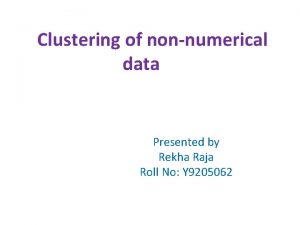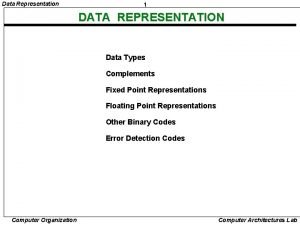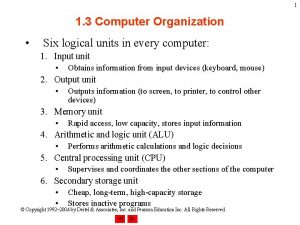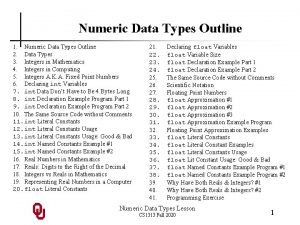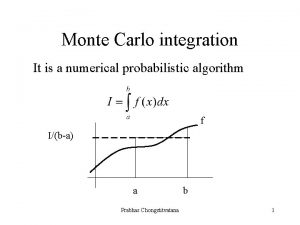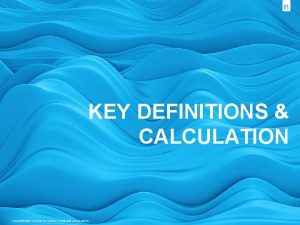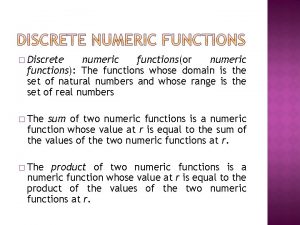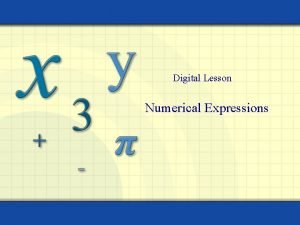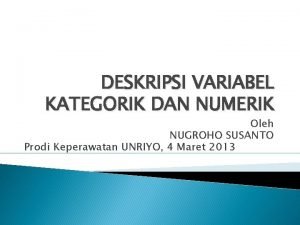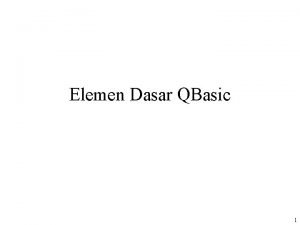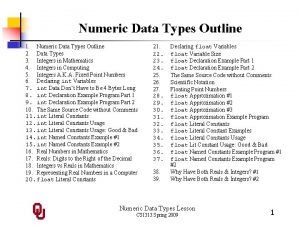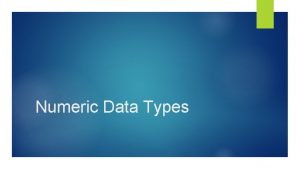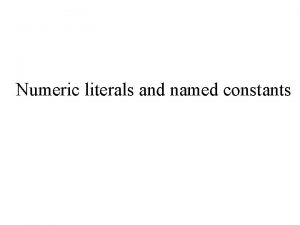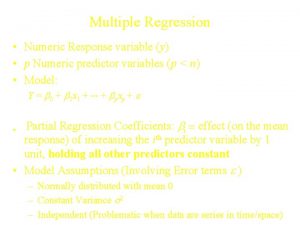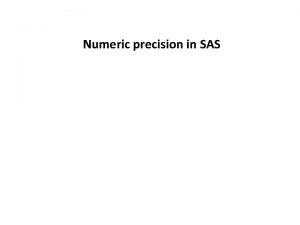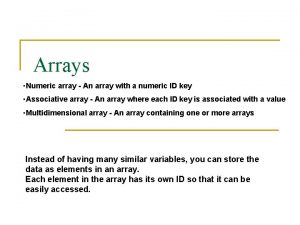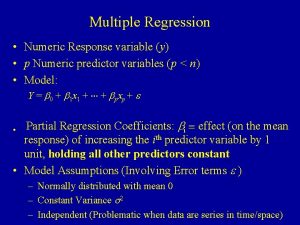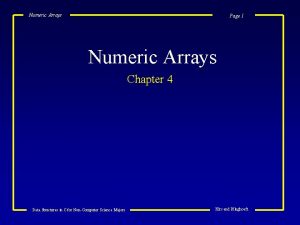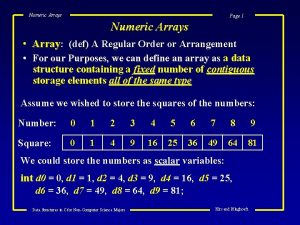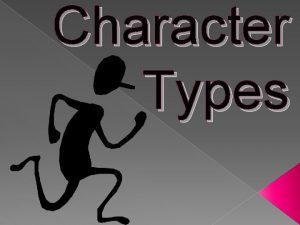Numeric Data Types There are six numeric data




















- Slides: 20

Numeric Data Types There are six numeric data types: byte, short, int, long, float, and double. Sample variable declarations: int i, j, k; float number. One, number. Two; long big. Integer; double big. Number;

Data Type Precisions The six data types differ in the precision of values they can store in memory.

Primitive Data Declaration and Assignments int first. Number, second. Number; first. Number = 234; second. Number = 87; A. Variables are allocated in memory. first. Number A int first. Number, , second. Number; ; first. Number = 234; B second. Number = 87; second. Number 234 87 B. Values are assigned to variables. Code State of Memory

Assigning Numeric Data int number; number = 237; number = 35; number 35 237 A. The variable int number; number = 237; number = 35; is allocated in memory. A B B. The value 237 C is assigned to number C. The value 35 overwrites the previous value 237. Code State of Memory

Numeric Data Types At the time a variable is declared, it also can be initialized. For example, we may initialize the integer variables count and height to 10 and 34 as int count = 10, height = 34; Ping … out to reality … Numeric. Variables. java

Numeric Literal Values Integer types can be Positive or negative Decimal, e. g. , -5653 Octal, e. g. , 05653 (but not 09876) Hexidecimal, e. g. , 0 x 5 A 1 Long, e. g. , 14084591234 L Real types can be Float, e. g. , 1. 23 f Double, e. g. , -2. 34 Scientific, e. g. , 2. 17 e-27 f or -456. 2345 e 19

Arithmetic Operators The following table summarizes the arithmetic operators available in Java. ++ and -- for integer type variables This is an integer division where the fractional part is truncated.

Arithmetic Expressions Examples: sum = first. Number + second. Number; avg = (one + two + three) / 3. 0; total++; Assignment operators Tral-la-la, out to reality … Numeric. Operators. java

Arithmetic Expressions How does the expression x + 3 * y get evaluated? Answer: x is added to 3*y. We determine the order of evaluation by following the precedence rules. A higher precedence operator is evaluated before the lower one. If two operators are the same precedence, then they are evaluated left to right for most operators.

Precedence Rules


Example Program Flonk … out to reality … Numeric. Precedence. java

Type Casting If x is a float and y is an int, what will be the data type of the following expression? x * y The answer is float. The above expression is called a mixed expression. The data types of the operands in mixed expressions are converted based on the promotion rules. The promotion rules ensure that the data type of the expression will be the same as the data type of an operand whose type has the highest precision.

Promotion Rules

Assignment Conversion If a lower precision value is assigned to a higher precision variable, type casting occurs Example double number; number = 25; is legal but int number; number = 23. 45; is not

Explicit Type Casting Instead of relying on the promotion rules, we can make an explicit type cast by prefixing the operand with the data type using the following syntax: ( <data type> ) <expression> Example (float) x / 3 (int) (x / y * 3. 0) Type case x to float and then divide it by 3. Type cast the result of the expression x / y * 3. 0 to int.

Example Program Fuuuurtang … out to reality … Numeric. Casting. java

Constants We can change the value of a variable. If we want the value to remain the same, we use a constant. final double PI = 3. 14159; final int MONTH_IN_YEAR = 12; final short FARADAY_CONSTANT = 23060; The reserved word final is used to declare constants. These are constants, also called named constant. These are called literal constant.

Use of Constants Very often class variables that are initialized May be private or public Local and instance variables may be declared final so they can be assigned a value only once Yabbadabba … out to reality … Final. Variables. java

The Math Class The Math class in the java. lang package includes many common and useful mathematical functions such sin, cos, tan, square root, exponentiation, and others. The mathematical formula is expressed in Java as Math. abs( Math. sin( Math. PI / 4. 0) * x ) Splodge … out to reality … Math. Functions. java
 Antigentest åre
Antigentest åre Numeric data types in java
Numeric data types in java Python numbers.number
Python numbers.number Weighted code
Weighted code Clustering non numeric data
Clustering non numeric data Data representation in computer organization
Data representation in computer organization Classify each polygon
Classify each polygon Statapult exercise instructions
Statapult exercise instructions 6 logical units of a computer
6 logical units of a computer Isced codes
Isced codes General alphabetic section of the numeric file
General alphabetic section of the numeric file Numeric outline
Numeric outline Numeric integral
Numeric integral Weighted distribution nielsen
Weighted distribution nielsen Discrete numeric functions
Discrete numeric functions Numeric expression example
Numeric expression example Variabel kategorikal
Variabel kategorikal Numeric constant in qbasic
Numeric constant in qbasic Numeric indicator
Numeric indicator Nprs scale
Nprs scale Ascii classification
Ascii classification

